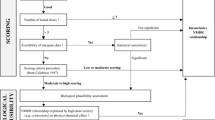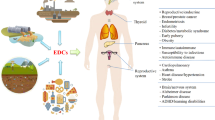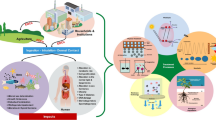Abstract
Experimental and epidemiological studies suggest that some man-made and naturally occurring chemicals related to the environment have the potential to interrupt normal functioning of the endocrine systems of humans and wildlife. These chemicals, termed EDCs (Endocrine disrupting Chemicals), pose serious threats to the reproductive capability of humans and wildlife. Because of the structural diversity and various types, development of structure-based rapid screening methodologies is important and necessary for the assessment of the environmental pollutants. In this paper molecular hologram based QSAR models were developed with the combinatory application of partial least square (PLS) regression for a large diverse set of 105 environmental estrogens. Quantitatively predictive models were developed based on only molecular structures, which can be used for the accurate prediction of estrogenicity to rapidly screen potential environmental endocrine disrupting chemicals.
Similar content being viewed by others
References
Cooper, R. L., Kavlock, R. J., Endocrine disruptors and reproductive development: a weight-of-evidence overview, J. Endocrine, 1997, 152: 159–166.
Wang, L. S., Han, S. K., Molecular structure-property-activity, Beijing: Chemical Industry Press, 1997.
Zacharewski, T., Identification and assessment of EDs: Limitations of in vivo and in vitro assays, Environ. Health. Perspect., 1998, 106(S2): 577–582.
Qi, W. Q., Sun, Z. G., Monitoring and Analysis of Trace Organic Pollutants, Beijing: Chemical Industry Press, 2001.
Wang, L. S., Han, S. K., QSARs of Organic Pollutants, Beijing: Environmental Science Press of China, 1993.
Lowis, D., HQSAR: A new, highly predictive QSAR technique, Tripos Technical Notes, Vol 1(5), Tripos Inc., 1997
Blair, R. M., Hong, F., Branham, W. S. et al., The estrogen receptor relative binding affinities of 188 natural and xenochemicals: structural diversity of ligands, Toxicol. Sci., 2000, 54: 138–153.
Hurst, T., Heritage, T., HQSAR-A highly predictive QSAR technique based on molecular holograms, 213th ACS Natl. Meeting, San Francisco, CA. 1997.
Ihlenfeldt, W. D., Gasteiger, J., Hash codes for the identification and classification of molecular structure elements, J. Comput. Chem., 1994,15: 793–813.
Wold, S., Johansson, E., Cochi, M., PLS—partial least squares projections to latent structures, 3D QSAR in Drug Design: Theory Methods and Applications (ed. Kubinyi, H.), ESCOM, Leiden, The Netherlands, 1993, 523–550.
Hong, H. X., Tong, W. D., Hong, F. et al., Prediction of estrogen receptor binding for 58,000 chemicals using an integrated system of a tree-based model with structural alerts, Environ. Health. Perspect., 2002, 110: 29–36.
Golbaikh, A., Tropsha, A., Beware of q2!, J. Mol. Graph. Model., 2002, 20: 269–276.
Waller, C. L., A Comparative QSAR study using CoMFA, HQSAR, and FRED/SKEYS paradigms for estrogen receptor binding affinities of structurally diverse compounds, J. Chem. Inf. Comput. Sci., 2004, 44: 758–765.
Shi, L. M., Hong, F., Tong, W. D. et al., QSAR models using a large diverse set of estrogens, J. Chem. Inf. Comput. Sci., 2001, 41: 186–195.
Wang, X. D., Tang., S. L., Liu, S. S. et al., Molecular hologram derived quantitative structure-property relationships to predict physico-chemical properties of polychlorinated biphenyls, Chemosphere, 2003, 51(7): 617–632.
Cui, S., Wang, X., Liu, S. et al., Predicting toxicity of benzene derivatives by molecular hologram derived quantitative structure-activity relationships (QSARS), SAR QSAR Environ. Res., 2003, 14(3): 223–231.
Author information
Authors and Affiliations
Corresponding author
Rights and permissions
About this article
Cite this article
Wang, X., Xiao, Q., Cui, S. et al. Holographic QSAR of environmental estrogens. Sc. China Ser. B-Chem. 48, 156–161 (2005). https://doi.org/10.1360/04yb0075
Received:
Issue Date:
DOI: https://doi.org/10.1360/04yb0075




